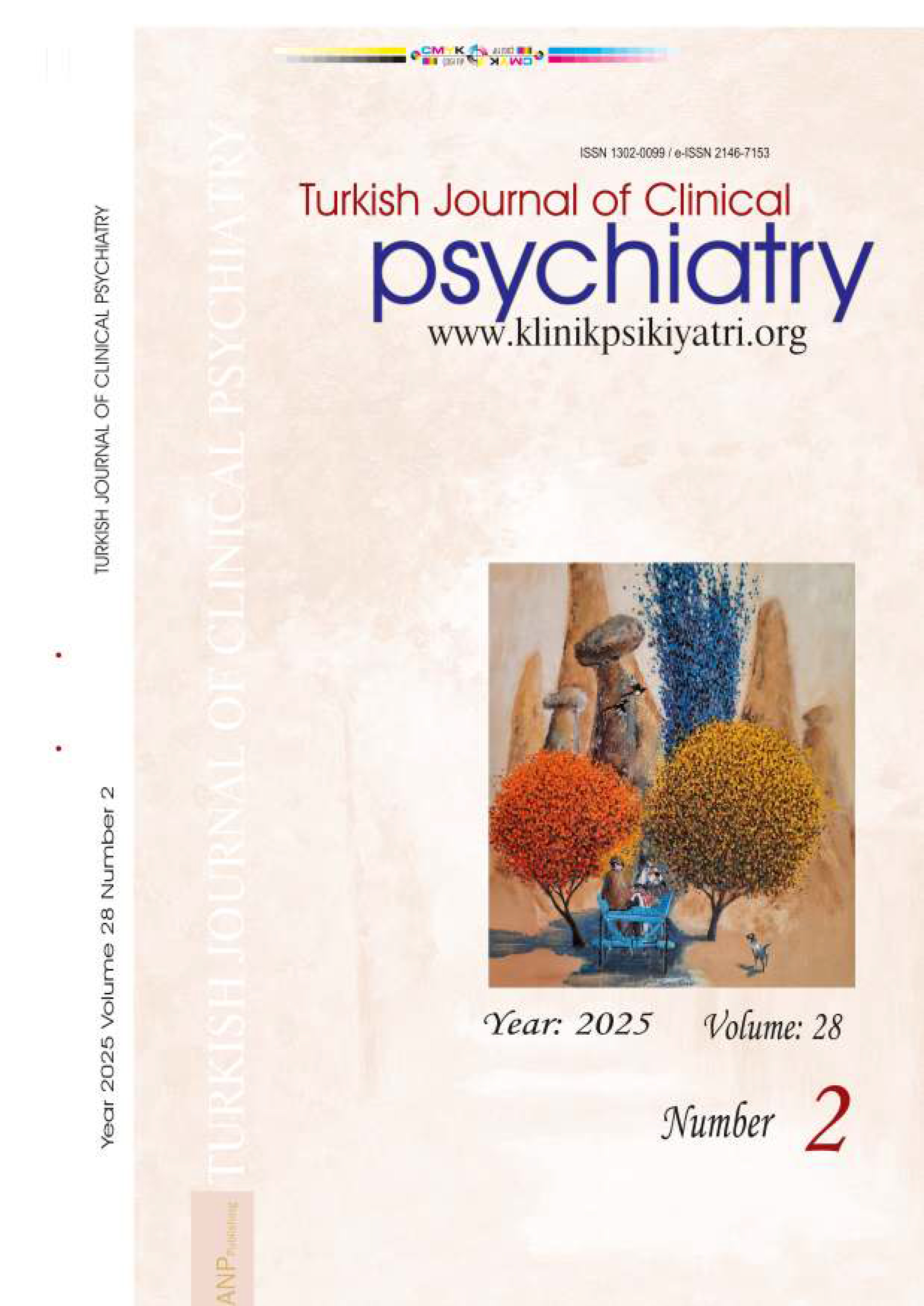





Volume: 5 Issue: 3 - 2002
| REVIEW | |
| 1. | Neural Networks in Brain and Related Clinical Features Görsev Yener Pages 135 - 138 Man have always wondered how the brain works. The practical consequence of this curiosity may lead to the diagnosis and treatment of clinical syndromes that are presently considered incurable. This article discusses the anatomical basis of the functioning brain. In this context, the Yakovlev model and the frontal- subcortical circuits that play a significant role on behavioral-cognitive patterns and the clinical implications of these networks are treated. |
| 2. | Theory and Application of Cognitive Functional Magnetic Resonance Imaging Hakkı KARAKAŞ Pages 139 - 144 Functional magnetic resonance imaging have made it possible to map brain activity based on changes in cerebral hemodynamics in response to cognitive processing. In the following paper, psychological approaches in describing cognitive processing, theoretical and technical backgrounds of functional magnetic resonance imaging, key points in designing experiments, and an example to application is presented. |
| 3. | Frontal and Parietal Dysfunction in Attention Deficit Hyperactivity Disorder Emel ERDOĞAN Pages 145 - 150 Neurological factors play an important role in the etiology of attention deficit hyperactivity disorder (ADHD). The present article discussed the neuropsychology of ADHD; it presented the relationship between neuropsychological test scores and the structural changes that occur in ADHD. It is pointed out that the imaging tehniques that are lately being widely used show the importance of the frontal and the parietal lobes in ADHD. |
| 4. | Neuropsychiatric Symptoms of Dementia, Parkinson's Disease, Multiple Sclerosis and AIDS Nevzat Yüksel Pages 151 - 159 Neurological conditions such as dementia, Parkinson's disease, HIV associated dementia and multiple sclerosis shows a constellation of cognitive and behavioral symptoms. These symptoms often do not fulfill the criteria for formal psychiatric diagnosis. Clinicians should be sensitive to complaints of the patients. Alzheimer's disease manifested by core features of progressive memory impairement, visuospatial decline, aphasia, and loss of executive function. Behavioral symptoms include depression, psychosis, and agitation. Despite these clinical features, there is clinical heterogeneity among patient with Alzheimer's disease. Patients with Alzheimer's disease may also present disproportionate visuospatial abnormalities, aphasia, posterior cortical atrophy, extrapyramidal symptoms, and prefrontal involvement; patients with vascular dementia show more depression and functionally impairments. Behavioral and psychiatric problems associated with Parkinson's disease include cognitive dysfunction, drug related psychosis, depression, anxiety, apathy, fatigue and sleep disturbances. These manifestation cause significant disability at all stages off illness. Neurologist's routiene office visits may fail to identify the presence depression and anxiety. Multiple sclerosis have a high lifetime risk for major depression. The presence of depression adversely affects patients perception of their disability. There is significant correlation between fatigue and mood level. The human immunodeficiency virus invades the central nervous system early after infection and it gives rise to cognitive, motor and behavioral manifestations ranging from mild impairements to frank dementia. Cognitive symptoms of HIV associated dementia include short-term memory and concentration impairements and mental slowing. Behavioral symptoms include social withdrawal, irritability, depression and personality change. |
| RESEARCH ARTICLE | |
| 5. | Examination of Factor Structure of Inteligence Test and Neuropsychological Tests Aynur ŞAHİN Pages 160 - 168 The aim of this study is to examine the factor structure of the Turkish Forms of Wechsler Memory Scale-Revised, Wisconsin Card Sorting Test and Judgement of Line Orientation Test togethe with Wechsler Adult Intelligence Scale. A total 110 subjects were used in this study. Principial Component Analysis was used to extract factors. The first exracted factor was called "General Ability" and it got loadings from 11 subtests. The second factor was called "Mental Flexibility" while the third was called "Perceptual Organization". The findings were discussed in the light of related literature. |
| 6. | Event-Related Potentials and Gamma Responses for Individuals Having High and Low Attention Performance Metehan IRAK, Sirel KARAKAŞ Pages 169 - 176 The aim of this study is to compare the gamma responses and event-related potentials (ERP) of individuals who were high- and low-performers on specific cognitive tasks that involved three different attention conditions. Thirty healthy college students (16women, 14 men) between the ages of 18-30 participated in the study. Experimental tasks pertained to focused attention paradigm (FA), divided attention paradigm (DA) and mismatch-negativity paradigm (MMN). Participants were divided into two groups according to their performance level (10 participants in each of the two groups). Attention condition and cognitive performance levels led to significant differences on P300 response amplitude and on the time window in which the gamma response has occurred. Results have been discussed in the light of the literature which focused on P300 changes as related to task difficulty and the sensory versus cognitive processing concomitants of the gamma response. |
| REVIEW | |
| 7. | The Relations Between Electrophysiological and Neuropsychological Measurements: Frontal Lobe Functioning Belma BEKÇİ, Sirel KARAKAŞ Pages 177 - 184 The goal of this study was to obtain the event-related potentials (ERP) under one cognitive paradigm and to examine the relationships between the ERP components and the neuropsychological test (NPT) scores. The sample consisted of participants who had at least 12 years of education, were between 19-67 years of age, were free of reported psychiatric or neurological disorders, and were not or had not been under medication that affects cognitive processes. Principle component analysis with varimax rotation was used to examine the relations between the ERPs that were obtained under the oddball paradigm (OB) from the Fz, Cz and Pz electrode locations with the Stroop Test TBAG Version. Results: The ERP pattern that was obtained in this study was similar to those obtained with the standard paradigm of the literature. Such findings show that ERP components of the present study are the reliable components of the literature. The results further showed that there were selective relations between cognitive ERPs values and NPT scores. According to these findings, the early electrophysiological activity, as indexed by the ERP components, can be used as predictors of specific long-lasting cognitive processes of humans, as indexed by NPT scores. |
| 8. | Healthy of Aging Effects on Neuroelectric Potentials Hatice KAFADAR, Sirel KARAKAŞ Pages 185 - 196 The aim of this study is to study the effect of age and experimental paradigm on event-related potentials (ERP) and event- related oscillations (ERO). The study utilized a 2x2x3 factorial design with age (19-24, 45-67), experimental paradigm (mismatch negativity, oddball), and electrode location as the experimental variables. Thirty five volunteer subjects who had a minimum of 12 years of education participated in the study. The analyses involved average EEG-ERPs, amplitude frequency characteristics and filtered EEG-ERPs for age, experimental paradigm and electrode location. The effect of the variables were statistically tested using analysis of variance for repeated measures. Results showed that the peak amplitudes for the 19-24 age group were higher than for the 45-67 age group. The filtered EEG-ERP waveforms varied according to age, experimental paradigm and electrode location. The amplitudes of the filtered waveforms were generally higher for the 19-24 age group than for the 45-67 age group. The amplitude frequency characteristics for the 19-24 age group demonstrated prominent maxima in the lower frequency ranges. Excepting the data for the 19-24 age group under the oddball paradigm, the theta response existed in a broad band with the delta response. Analysis of variance for repeated measures showed that paradigm and electrode location affected all ERP components. The results of the analyses showed that the neuroelectric responses of the brain changes with age. |
| 9. | Intelligence Profile in Different Epilepsy Types Şebnem Soysal, Kürşad AYDIN, Çetin OKUYAZ, Kıvılcım GÜCÜYENER, Ayşe Serdaroğlu Pages 197 - 204 Epilepsy is one of the most common disorders in childhood. Neuropsychological disorders are encountered more in the epileptic population than the general population. Underlying neuropathologies, ictal-interictal neuronal discharges and antiepileptic drugs are main conditions that cause neuropsychological pathology. In this study, the neuropsychological effects of different epilepsy types were evaluated. One hundred three epileptic children (idiopathic children 56, symptomatic epileptic children 47) who take monotherapy and have seizures in the moderate range were included in this study. The WISC-R scores were compared on the basis of seizure type (symptomatic, idiopathic) and sex (girls, boys). The scores for the Coding subtest were higher in idiopathic epileptic children than symptomatic epileptic children. Scores for Information and Similarities subtests of boys were found to be higher than that of girls. The scores for Similarities and Performance IQ of idiopathic epileptic girls were found to be higher than those of symptomatic epileptic girls. These findings showed that the neuropsychological effects of different types of epilepsy types are different. |










